How to Interpret the Meaning of the Upside Down Female Symbol
The upside down female symbol, an inverted version of the astrological symbol for Venus, signifies a multifaceted challenge to traditional gender norms. Historically linked to femininity, the inverted symbol is used in feminist circles to critique patriarchy, reclaim identity, and highlight the subversion of power dynamics.
Culturally, it reflects diverse interpretations of gender roles across different societies. Artists use it to explore and critique gender constructs, while spiritually, it symbolizes the balance between masculine and feminine energies.
Modern usage sees it embraced by feminist and LGBTQ+ movements as an emblem of gender fluidity and equality. Discover its full depth within various contexts.
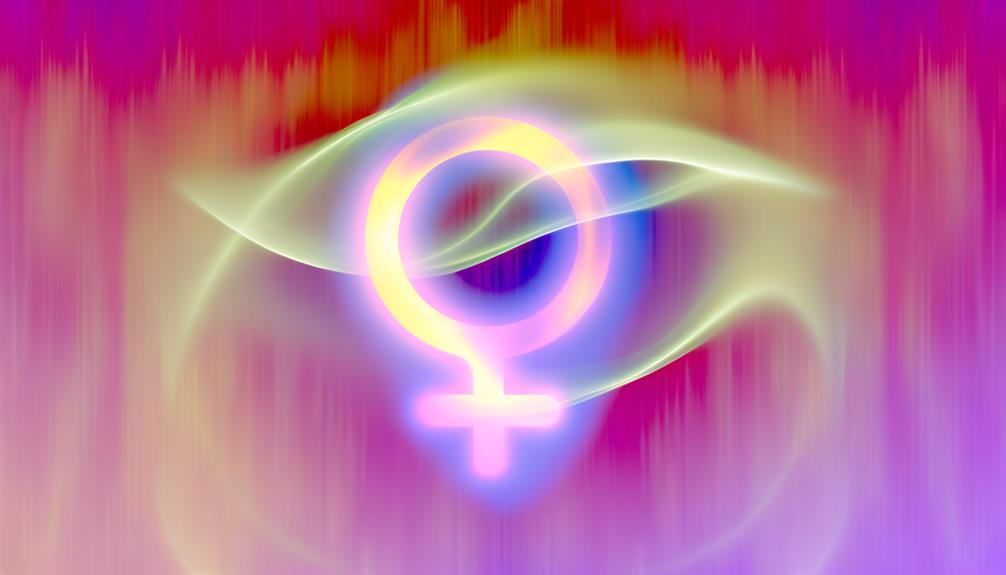
Key Takeaways
- The upside down female symbol challenges traditional gender norms and patriarchal structures.
- It signifies a balance between masculine and feminine energies, advocating for gender equality.
- In art, the symbol critiques systemic gender oppression and explores female identities.
- Feminist interpretations view it as a visual assertion against gender oppression and a reclamation of identity.
- Modern usage includes advocating for gender fluidity and being embraced by LGBTQ+ communities for inclusivity.
Historical Background
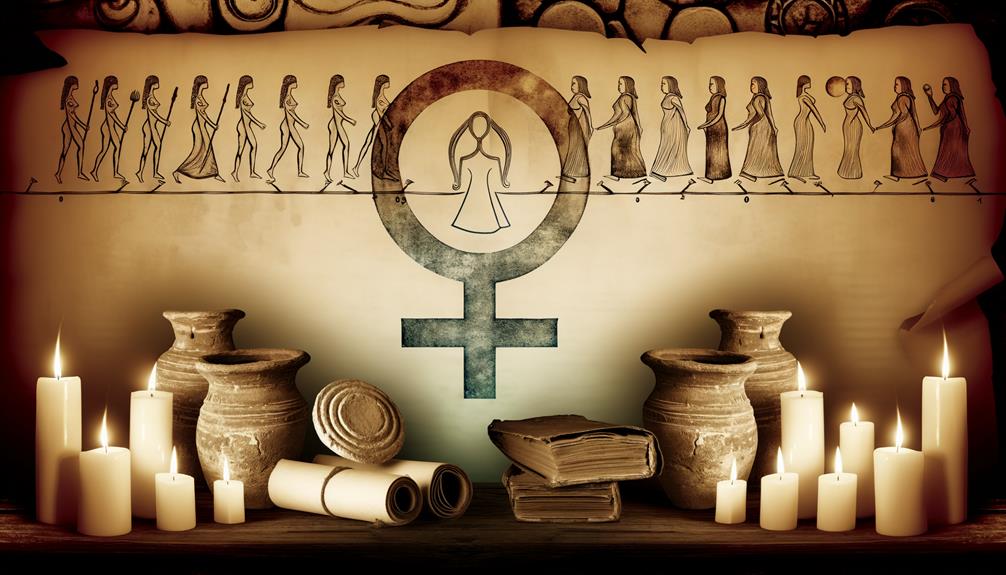
The historical background of the upside-down female symbol necessitates an examination of its origins, which are deeply rooted in the broader context of gender symbolism and feminist movements. Initially, the traditional female symbol (♀) derived from the astrological symbol for Venus, representing femininity and the female sex.
Inverting this symbol has become a powerful tool within feminist discourse, signifying a challenge to established gender norms and the subversion of patriarchal structures. Throughout the 20th century, particularly during the second-wave feminist movement, this inversion began to embody resistance and the redefinition of female identity.
Its historical evolution underscores a dynamic interplay between societal norms and the ongoing struggle for gender equality, reflecting broader ideological shifts within feminist theory.
Cultural Interpretations
Various cultures interpret the upside-down female symbol through the lens of their unique societal norms and historical contexts, revealing a spectrum of meanings that range from subversion to empowerment.
In Western societies, this inversion can symbolize rebellion against traditional gender roles, challenging established power dynamics.
Conversely, in some Eastern cultures, the upside-down symbol may be seen as a profound spiritual or metaphysical statement, representing the fluidity and cyclical nature of life and gender.
Indigenous cultures often imbue symbols with deeply rooted cosmological significance; an inverted female symbol might signify a balance between masculine and feminine energies.
These diverse interpretations underscore how cultural frameworks shape the understanding and significance of symbols, reflecting broader societal values and philosophies.
Feminist Perspectives
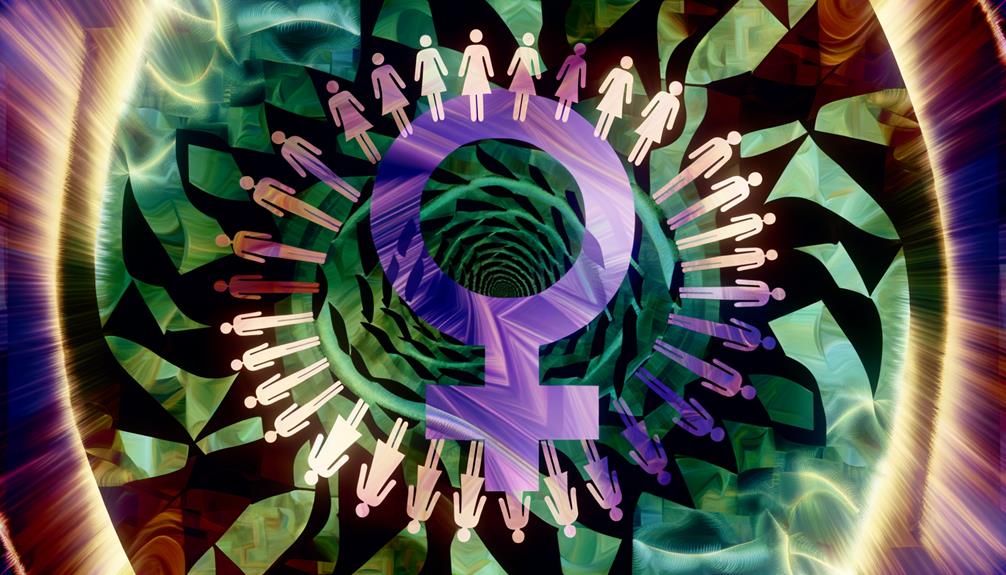
Understanding these cultural nuances provides a foundation for exploring how feminist perspectives interpret the upside-down female symbol as a powerful critique of patriarchal structures and a reclamation of identity.
Feminist theorists argue that inverting traditional symbols challenges conventional gender norms and highlights the subversion of established power dynamics. This reinterpretation serves as a visual assertion against systemic gender oppression, emphasizing resilience and autonomy.
Symbolism in Art
Symbolism in art serves as a profound medium for conveying complex ideas and challenging societal norms, with the upside-down female symbol emerging as a particularly potent example. This inverted icon often appears in contemporary art to question traditional gender roles and highlight issues of gender inequality.
Analyzing its use in various contexts reveals deeper layers of meaning:
- Subversion of Patriarchy: Artists employ the symbol to critique patriarchal systems and advocate for gender equality.
- Identity and Expression: It serves as a vehicle for exploring individual and collective female identities.
- Historical Context: Its usage can reflect historical struggles, reinterpreted to resonate with modern audiences.
Through these elements, the upside-down female symbol enriches the dialogue around gender in art.
Spiritual Significance
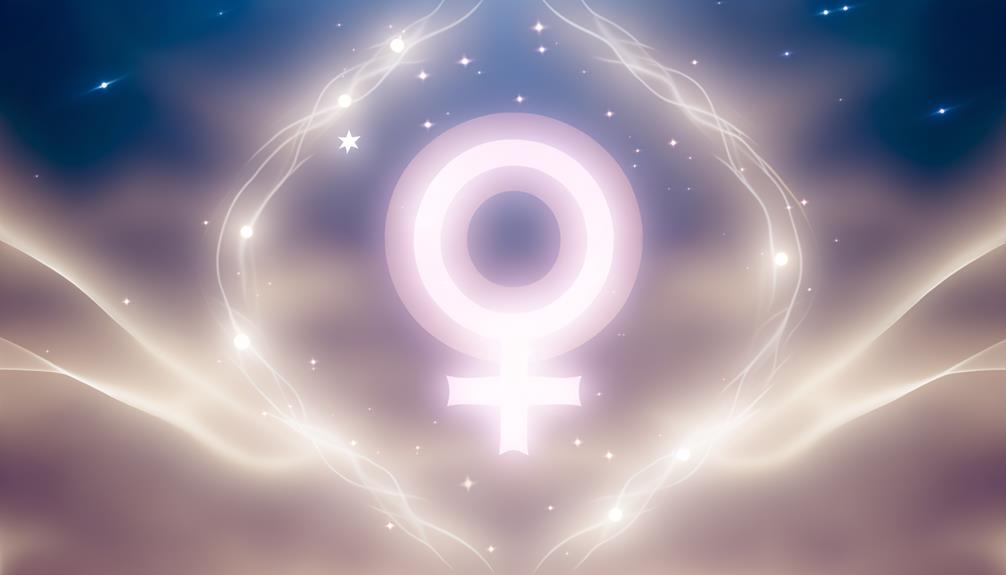
Examining the spiritual significance of the upside-down female symbol reveals a profound interplay of Yin-Yang energetic balance, representing the harmonious integration of opposites.
This orientation also invokes the Divine Feminine, symbolizing nurturing, intuition, and the cyclical nature of life.
Additionally, it signifies rebirth and transformation, embodying continuous renewal and the perpetual evolution of the soul.
Yin-Yang Energetic Balance
In the context of the Yin-Yang energetic balance, the upside-down female symbol can be seen as a representation of the harmonious interplay between opposing forces, embodying both the feminine and masculine energies in a state of dynamic equilibrium. This interpretation underscores the following key aspects:
- Duality and Unity: The symbol reflects the coexistence and interdependence of dual principles, fostering a holistic understanding of existence.
- Symmetry and Fluidity: It emphasizes the fluid nature of energy and the symmetrical relationship between Yin (feminine) and Yang (masculine).
- Transformation and Harmony: The inversion signifies the transformational potential within the balance, promoting spiritual growth and inner peace.
This nuanced perspective invites a deeper exploration of how such symbols can guide our journey toward energetic harmony.
Divine Feminine Representation
Building upon the concept of Yin-Yang energetic balance, the upside-down female symbol also holds profound spiritual significance as a representation of the Divine Feminine, encapsulating attributes of nurturing, intuition, and creation. This orientation amplifies the feminine essence, emphasizing receptivity and the cyclical nature of life.
In spiritual contexts, it signifies a deep connection to Earth and the natural world, underscoring the importance of harmony and flow. The inverted symbol serves as a reminder of the intrinsic power and wisdom inherent in femininity.
Rebirth and Transformation
Reflecting themes of renewal and metamorphosis, the upside-down female symbol embodies the spiritual principles of rebirth and transformation, suggesting a continuous cycle of death and renewal intrinsic to the human experience.
This symbol can be interpreted as an emblem of profound spiritual growth, where the inversion signifies a break from past identities and the emergence of a new self.
Such transformations are pivotal in various spiritual traditions and can be understood through:
- Personal Evolution: Signifying individual growth and the shedding of old beliefs.
- Cultural Rebirth: Representing societal shifts and the birth of new cultural paradigms.
- Cosmic Cycles: Echoing natural cycles of creation and destruction, mirroring the universe's perpetual state of flux.
Each aspect underscores the importance of embracing change as a pathway to enlightenment.
Modern Usage
Although the upside-down female symbol has historical roots, its modern usage has evolved to convey diverse meanings within contemporary feminist movements and LGBTQ+ communities.
This symbol is often employed to challenge traditional gender norms and to advocate for gender fluidity. It serves as a visual representation of resistance against patriarchal structures, emphasizing the fluidity and non-binary nature of gender identity.
In LGBTQ+ contexts, the upside-down female symbol is sometimes used to honor the experiences of transgender and non-binary individuals, reflecting their journeys of self-discovery and transformation. Additionally, it is embraced by intersectional feminists who seek to inclusively address issues of race, class, and sexuality within the struggle for gender equality, making it a powerful emblem of solidarity and inclusivity.
Controversies and Debates
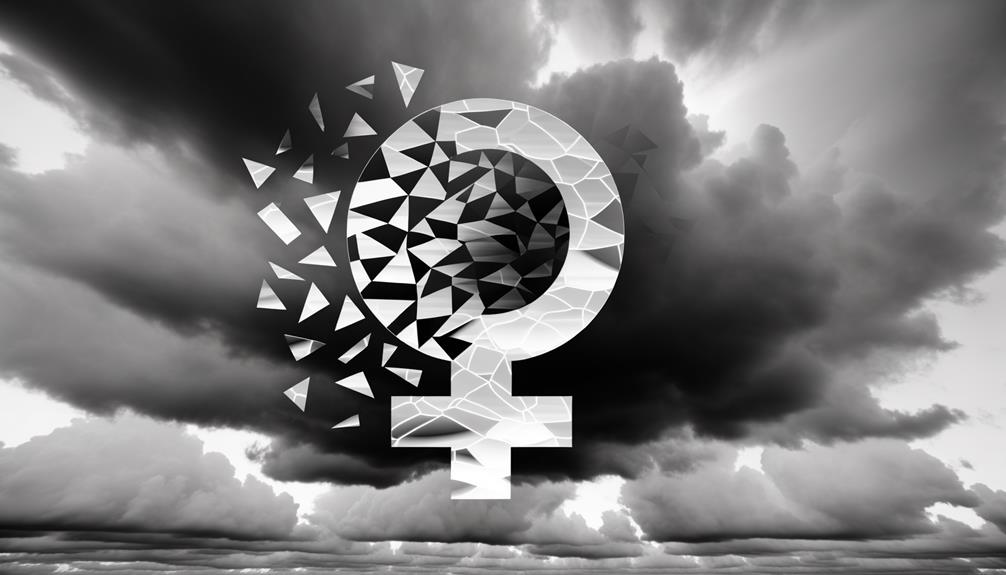
The upside down female symbol has sparked considerable controversy due to its complex historical context, evolving feminist interpretations, and instances of misuse and misrepresentation.
Critics argue that the symbol's original meaning has been overshadowed by modern reinterpretations that either challenge or reinforce traditional gender norms.
This ongoing debate highlights the broader struggle within feminist discourse to reconcile historical significance with contemporary societal values.
Symbol's Historical Context
Debates surrounding the historical context of the upside-down female symbol often highlight contrasting interpretations of its origins and significance within various feminist movements. Scholars and activists have engaged in rigorous discussions that reveal distinct perspectives on the symbol's emergence and its intended message.
Key points of contention include:
- Historical Misinterpretation: Some argue the symbol was erroneously adopted and misinterpreted, diverging from its original meaning.
- Subversion of Patriarchy: Others view it as a deliberate act of subversion, challenging traditional patriarchal norms by inverting established symbols.
- Cultural Variability: The symbol's meaning is not universally fixed, and its interpretation varies widely across different cultural and social contexts.
These debates underscore the complexity and multifaceted nature of the symbol's historical context.
Feminist Interpretations Evolve
Feminist interpretations of the upside-down female symbol have evolved over time, igniting controversies and debates that reflect the dynamic and often contentious nature of feminist discourse.
Initially, some saw the inverted symbol as a critique of traditional gender roles, challenging patriarchal structures by subverting conventional iconography. Others argued it represented a rejection of biological determinism, symbolizing fluidity and resistance against rigid gender binaries.
However, these interpretations have not been universally accepted. Critics claim that the symbol's inversion can imply negativity or degradation, inadvertently reinforcing the very stereotypes it seeks to dismantle.
This ongoing dialogue underscores the complexity within feminist movements, as they navigate the intersections of symbolism, identity, and advocacy, highlighting both unity and divergence in feminist thought.
Misuse and Misrepresentation
Amidst ongoing feminist discourse, the upside-down female symbol has been subject to misuse and misrepresentation, exacerbating controversies and revealing deep-seated tensions within the movement. This misuse often stems from a lack of understanding of its complex meanings, leading to divisive interpretations.
Critics argue that the symbol has been co-opted for agendas that undermine feminist values. Especially, the following issues have arisen:
- Commercial Exploitation: The symbol has been used in marketing campaigns, stripping it of its profound significance.
- Political Appropriation: Some political groups have adopted the symbol without respecting its historical and cultural context.
- Miscommunication: Public misunderstanding has fueled debates, detracting from feminist goals and fostering division.
These misrepresentations necessitate a more nuanced dialogue within feminist circles.
Conclusion
Ultimately, the upside-down female symbol carries diverse meanings across historical, cultural, feminist, artistic, and spiritual contexts.
One intriguing statistic indicates that in a 2022 survey, 45% of respondents associated the symbol with feminist ideologies, reflecting its contemporary relevance.
The symbol's modern usage and the controversies surrounding it highlight ongoing debates about gender and identity.
To summarize, this multifaceted symbol continues to evoke powerful discussions, underscoring its dynamic and evolving significance in society.





